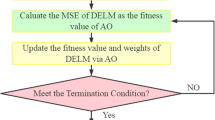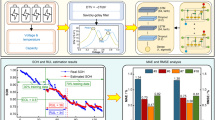Abstract
Lithium-ion batteries are widely used in the field of electric vehicles and energy storage due to their superior performance. However, with increased use time, lithium-ion battery performance declines significantly, which can indirectly lead to the decline of device performance or failure. Therefore, accurate prediction of the remaining useful life (RUL) of lithium-ion batteries enables timely maintenance and replacement of batteries to ensure safe and reliable operation. In this paper, a hybrid network model is constructed by combining a long and short-term memory network with a gated unit recurrent network, and a RUL prediction method for lithium-ion batteries based on variational modal decomposition and GRU/LSTM hybrid network model is proposed. The method is divided into two stages: the estimation of SOH and the prediction of RUL. In the SOH estimation stage, four easily collected lithium-ion battery health indices are used to estimate the SOH of lithium-ion battery through a hybrid GRU/LSTM network. In the RUL prediction stage, the SOH data obtained in the previous stage are firstly decomposed by the VMD method to reduce the effects of capacity regeneration and other noises. Then, on the basis of the SOH data processed by VMD, a hybrid GRU/LSTM network is used for accurate prediction of the remaining lifetime of the lithium-ion battery. The proposed method is validated by NASA battery dataset and CALCE battery dataset, and compared with GRU method, LSTM method and Bi-LSTM method. The experimental results show that the VMD-GRU/LSTM two-stage prediction method can predict RUL of lithium battery more accurately, and has good robustness and generalization.







Similar content being viewed by others
Data Availability
The experimental data used in this paper are from the National Aeronautics and Space Administration Prognostics Center of Excellence (NASA) and the Center for Advanced Life Cycle Engineering Research (CALCE).
References
Shu, X., Liu, Y.G., Shen, J.W., et al.: Capacity prediction of lithium-ion batteries based on improved least squares support vector machine with Box-Cox transform. J. Mech. Eng. 57(14), 118–128 (2021)
Jian, X.Z., Wei, J., Wang, R.Z.: Remaining life prediction of lithium-ion batteries based on RPMDE-MKSVM. Control. Eng. 28(04), 665–671 (2021)
Xiong, R., Li, L., Tian, J.: Towards a smarter battery management system: a critical review on battery state of health monitoring methods. J. Power Sources 405, 18–29 (2018)
Deng, Z.W., Yang, L., Deng, H.: Polynomial approximation pseudo-two-dimensional battery model for online application in embedded battery management system. Energy 142(1), 838–850 (2018)
Yang, L., Cai, Y.S., Yang, Y.X.: Supervisory long-term prediction of state of available power for lithium-ion batteries in electric vehicles. Appl Energy 257, 114006 (2020)
Hu, X.S., Le, Xu., Lin, X.K., Pecht, M.: Battery lifetime prognostics. Joule 4(2), 310–346 (2020)
Son, J.B., Zhou, S.Y., Sankavaram, C.: Remaining useful life prediction based on noisy condition monitoring signals using constrained Kalman filter. Reliab. Eng. Syst. Saf. 152, 38e50 (2016)
Wang, D., Yang, F.F., Tsui, K.L.: Remaining useful life prediction of lithium-ion batteries based on spherical cubature particle filter. IEEE Trans. Instrum. Meas. 65(6), 1282–1291 (2016)
Wei, H.E., Williard, N., Osterman, M.: Prognostics of lithium-ion batteries based on Dempster–Shafer theory and the Bayesian Monte Carlo method. J. Power Sources 196(23), 10314–10321 (2011)
Guha, A., Patra, A.: Online estimation of the electrochemical impedance spectrum and remaining useful life of lithium-ion batteries. IEEE Trans. Instrum. Meas. 67(8), 1836–1849 (2018)
Chen, Z.W., Shi, N.A., Ji, Y.F., Niu, M., Wang, Y.R.: Lithium-ion batteries remaining useful life prediction based on BLS-RVM. Energy 234, 121269 (2021)
Wang, Y.Z., Ni, Y.L., Zheng, Y.Q., et al.: Remaining service life prediction of lithium-ion batteries based on ALO-SVR. Chin. J. Electr. Eng. 41(04), 1445–1457 (2021)
Xu, J.N., Ni, Y.L., Zhu, C.B.: Prediction of the remaining life of lithium battery based on improved support vector regression. Trans. China Electrotech. Soc. 36(17), 3693–3704 (2021)
Liang, H.F., Yuan, P., Gao, Y.J.: Remaining service life measurement of lithium-ion battery based on CNN-Bi-LSTM network. Power Autom. Equip. 41(10), 213–219 (2021)
Hu, T.Z., Yu, J.B.: Lifetime prediction of lithium batteries based on multiscale decomposition and deep learning. J. Zhejiang Univ. (Eng. Edn.) 53(10), 1852–1864 (2019)
Xiang, M., He, Y.G., Zhang, H.: Remaining capacity and life prediction method of lithium-ion battery based on improved integrated empirical mode decomposition and Gaussian process regression. Electr. Measur. Instrum. 2, 1–8 (2020)
Li, X.Y., Zhang, L., Wang, Z.P., et al.: Remaining useful life prediction for lithium-ion batteries based on a hybrid model combining the long short-term memory and Elman neural networks. J. Energy Storage 21, 510 (2019)
Zhou, Y., Huang, M.: Lithium-ion batteries remaining useful life prediction based on a mixture of empirical mode decomposition and ARIMA model. Microelectron. Reliab. 65, 263 (2016)
Shi, Y.S., Shi, M.Z., Ding, E.S., et al.: Lifetime prediction method of lithium-ion battery based on CEEMDAN-LSTM combination. J. Eng. Sci. 43(07), 985–994 (2021)
Wang, R., Hou, Q.L., Shi, R.Y., et al.: Lithium battery remaining life prediction method based on variational modal decomposition and integrated depth model. Chin. J. Sci. Instrum. 42(04), 111–120 (2021)
Olivares, B.E., Cerda Munoz, M.A., Orchard, M.E.: Particle-filtering-based prognosis framework for energy storage devices with a statistical characterization of state-of-health regeneration phenomena. IEEE Trans. Instru. Measur. 62(2), 36476 (2013)
Dragomiretskiy, K., Zosso, D.: Variational mode decomposition. IEEE Trans. Signal Process. 62(3), 531–544 (2014)
Deihimi, A., Orang, O., Showkati, H.: Short-term electric load and temperature forecasting using wavelet echo state networks with neural reconstruction. Energy 57(9), 382–401 (2013)
Fischer, T., Krauss, C.: Deep learning with long short-term memory networks for financial market predictions. Eur. J. Oper. Res. 270(2), 654–669 (2017)
Geng, H., Sun, J.H., Li, Y., Wei, Y.C.: Prediction of novel coronavirus pneumonia outbreak based on BiGRU-Attention network. J. Wuhan Univ. Sci. Technol. 45(01), 75–80 (2022)
He, X.W., Xue, J.J., Wang, B., et al.: Research on cloud computing resource load prediction based on combined GRU-LSTM model. Comput. Eng. 2, 1–11 (2020)
Cheng, G., Wang, X.Z., He, Y.R.: Remaining useful life and state of health prediction for lithium batteries based on empirical mode decomposition and a long and short memory neural network. Energy 232, 121022 (2021)
Liu, J., Chen, Z.Q., Huang, D.Y., et al.: Remaining useful life of lithium-ion batteries based on time interval of equal charging voltage difference. J. Shanghai Jiaotong Univ. 53(9), 1058 (2019)
Funding
This work was supported by fund of Hubei Key Laboratory of Metallurgical Industry Process System Science (No. Y202007) and National Natural Science Foundation of China (No. 51877161).
Author information
Authors and Affiliations
Contributions
LH and GD wrote the main manuscript text and WW made critical revisions to the paper and provided fund support. All authors reviewed the manuscript.
Corresponding author
Ethics declarations
Competing interest
The authors declare no competing interest.
Ethical Approval
This article does not involve ethical issues.
Additional information
Publisher's Note
Springer Nature remains neutral with regard to jurisdictional claims in published maps and institutional affiliations.
Rights and permissions
Springer Nature or its licensor (e.g. a society or other partner) holds exclusive rights to this article under a publishing agreement with the author(s) or other rightsholder(s); author self-archiving of the accepted manuscript version of this article is solely governed by the terms of such publishing agreement and applicable law.
About this article
Cite this article
Hu, L., Wang, W. & Ding, G. RUL prediction for lithium-ion batteries based on variational mode decomposition and hybrid network model. SIViP 17, 3109–3117 (2023). https://doi.org/10.1007/s11760-023-02532-z
Received:
Revised:
Accepted:
Published:
Issue Date:
DOI: https://doi.org/10.1007/s11760-023-02532-z




